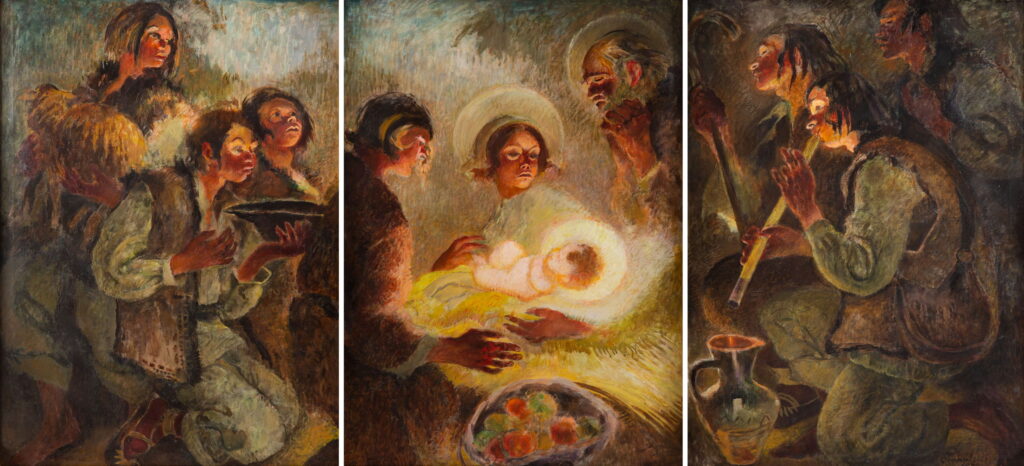Reading Visual Art: 204 Triptychs B

By the late nineteenth century, the classical format of the triptych that had been developed for altarpieces, was being used to tell secular stories as well as more traditional religious ones. Some artists had abandoned the use of three hinged panels intended to stand unsupported, and set three paintings within a single frame to be hung on a wall instead. Popular layouts included a central theme with subordinate wings, and a sequence read from left to right.
Constantin Meunier (1831–1905), Triptych of the Mine (Descent, Calvary, Ascent) (date not known), oil on canvas, dimensions not known, Meunier Museum, Brussels, Belgium. Image by Szilas, via Wikimedia Commons.
Constantin Meunier’s undated Triptych of the Mine is intended as a tribute to long-suffering underground workers, and makes a parallel with triptychs showing the Crucifixion. The left wing shows their descent, the centre their ascent of Calvary, and the right their ascent to surface at the end of their working day.
Akseli Gallen-Kallela (1865–1931), Aino Myth, Triptych (1891), oil on canvas, overall 200 x 413 cm, middle panel 154 x 154 cm, outer panels 154 x 77 cm, Ateneum, Helsinki. Wikimedia Commons.
Akseli Gallen-Kallela’s Aino Myth (1891) is set in a gilt frame with quoted text from the Kalevala inset, similar to Arthur Hughes arrangement from 1856. This shows scenes from Songs 4-5 of the Finnish national epic, the Kalevala.
The left panel shows the first meeting between Väinämöinen, the central figure and hero of the epic, and the young Aino, Joukahainen’s sister, in the forest. The perpetually ancient Väinämöinen there asks Aino to be his wife, to her shock and anger. The girl runs back to her mother in tears, but she offers no sympathy, telling her to stop crying, and to rejoice at the offer.
Aino remains distressed at the prospect of marrying such an old man, so wonders off, and becomes lost in the forest. She comes across the shore of a strange lake, where she sees the maids of Vellamo playing in the water, as shown in the right panel. She enters the water to wash, and drowns.
In Song 5, Väinämöinen goes to fish for Aino in the lake, and catches a salmon, which he tries unsuccessfully to cut up, so the fish slips back into the water. It then changes into Aino, who mocks Väinämöinen that he may have held her in his hands, but he cannot keep her, shown in the centre panel. She then disappears, and Väinämöinen travels to Pohjola to court the Maiden there.
Édouard Vuillard (1868–1940), Public Gardens (1894), oil on canvas, 213 x 308 cm, Musée d’Orsay, Paris. Wikimedia Commons.
In 1894, Édouard Vuillard painted this large triptych of Public Gardens, where its panels form a continuous landscape view and divide its figures into three groups. At the left is a group of carers with children; in the centre is a trio of ladies, one of them cradling an infant, and at the right is an older woman sat alone wearing the black of widowhood.
Léon Frédéric (1856–1940), The Ages of the Worker (c 1905), oil on canvas, dimensions not known, Musée d’Orsay, Paris. Wikimedia Commons.
Léon Frédéric’s Ages of the Worker from about 1905 is set in the crowded streets of a Belgian town. The left panel shows men engaged in manual labour, including two who are moving heavy props from a mine. In the centre, a group of young boys are enjoying an improvised meal on the pavement as young couples and a miner move around them. At the right, women are feeding and caring for their infants. I suspect that Frédéric may have intended the work to be read from right to left, rather than in the more usual direction.
Fedir Krychevskyi (1879–1947), Life (triptych: Love, Family, Return, l to r) (1925-29), tempera on canvas, 177 x 85, 148 x 133.5, 178 x 89 cm, National Art Museum of Ukraine Національний художній музей України, Kyiv, Ukraine. Wikimedia Commons.
Fedir Krychevskyi painted this triptych of Life in the latter half of the 1920s, and its centre panel was the most acclaimed work among paintings by Ukrainian artists shown at the Venice Biennale in 1928. From the left, its panels are titled Love, Family and Return. It blends his own distinctive approach with Art Nouveau, Klimt and mediaeval wall painting.
Henri-Jean Guillaume Martin (1860–1943), Le Monument aux morts (The Memorial) (1932), oil, dimensions not known, Musée de Cahors Henri-Martin, Cahors, France. Wikimedia Commons.
The Memorial was painted by Henri-Jean Guillaume Martin in 1932 as a public commission for the town of Cahors in southwest France. Its single continuous scene shows a commemoration of the dead of the First World War, centred symmetrically on the town’s war memorial.
Kazimierz Sichulski (1879–1942), Adoration of the Shepherds triptych (1938), oil on canvas, 102 x 222 cm, Private collection. Wikimedia Commons.
In the early decades of the twentieth century, Kazimierz Sichulski painted several large triptychs of the Hutsul peoples, including this Adoration of the Shepherds in 1938. Although modern in style, this is laid out as a traditional Nativity, with the Virgin and Child in the centre, and shepherds looking on from its wings.
Reading larger polyptychs can be a greater challenge.
Jan van Eyck (c 1390–1441) and Hubert van Eyck (c 1366-1426), The Ghent Altarpiece (c 1432), oil on panel, open overall 350 x 461 cm, Saint Bavo Cathedral, Gent, Belgium. Wikimedia Commons.
Among the most remarkable is The Ghent Altarpiece painted by the van Eyck brothers and their workshop in about 1432 for Saint Bavo Cathedral in Gent, Belgium. Its twelve panels are arrayed around the central panorama of the adoration of the Lamb of God. Its upper register features an array of figures with Adam and Eve outermost, and either Christ the King or God the Father at its centre. The lower register includes a gathering set against a continuous landscape background.
Polyptychs are also common outside Europe, including in East Asia where they were popular on screens. Some were also made from groups of woodblock prints.
Kitagawa Utamaro (喜多川 歌麿) (c 1754-1806), (Girl Fishers and Bathers) (1791), triptych of woodblock prints, 18.9 x 37.1 cm, Metropolitan Museum of Art, New York, NY. Wikimedia Commons.
Kitagawa Utamaro’s (喜多川 歌麿) Girl Fishers and Bathers from 1791 shows seaside activities at Enoshima. Although composed as a triptych with a continuous motif, the same topless woman appears in each of the sheets, making the whole a multiplex narrative. It’s not clear, though, whether it was intended to be read from left to right, or in reverse.




